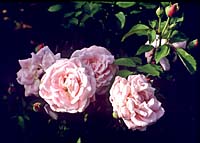Dr. Bill Welch
Professor and Extension Landscape Specialist
Foreshadowed by modern hybrids, old roses have been overlooked in this century; but now there is a renaissance afoot to restore the older varieties to their rightful place in the garden. These plants are incredible not only for their survival but for their garden virtues.  They climb, ramble, trail and form bushes large and small. They bloom steadily for several seasons or bloom overwhelmingly for one. They can be used as the background for a bed, or form its backbone, or be massed for color in the foreground. They will even settle happily into containers for those who have no garden space at all. Their colors tend to be lush and muted rather than hard and bright, enabling them to blend well, not only with each other, but with everything else in a garden setting.
They climb, ramble, trail and form bushes large and small. They bloom steadily for several seasons or bloom overwhelmingly for one. They can be used as the background for a bed, or form its backbone, or be massed for color in the foreground. They will even settle happily into containers for those who have no garden space at all. Their colors tend to be lush and muted rather than hard and bright, enabling them to blend well, not only with each other, but with everything else in a garden setting.
Their historic interest, color fragrance, and form should make old roses as indispensable to today’s gardens as they have been for centuries. Many gardeners will attest, the best thing about old roses is that they provide all these landscape values without becoming a maintenance burden. Unlike modern roses, which grow poorly without many hours of devoted attention, most old roses will give today’s busy homeowner an appreciated rest from much of the heavy fertilizing, spraying, and nurturing demanded by their younger cousins. And as specimens found in old cemeteries and abandoned homesites attest, many have survived even without care from human hands.
PREPARING A ROSE BED
Old Garden Roses are hardy even in poor conditions, but they will be at their lovely best if planted in a favorable situation with rich, well drained soil. The best place to locate a rosebed is in an open area that receives at least six hours of direct sun daily (preferably in the morning) and allows good healthy air movement around each bush.
Soil preparation will make a great difference in the health and long term vigor of your roses. Adding a quantity of organic material to be bed before planting will both enrich a sandy soil and break up a heavy soil to allow proper drainage.
PLANTING THE ROSES
To prevent the roses from drying out during planting, soak for about an hour (but not overnight) in a bucket of water. Dig the hole large enough to accommodate the natural spread of the roots. The plants should be set at approximately the same level at which they had been growing or slightly deeper. Prune any roots damaged in shipping, and spread the roots down around a pyramid of soil in the hole.
MULCHING AND WATERING
A several inch thick layer of mulch applied 2 or 3 times a year means fewer weeds, less water stress, less heat stress, richer soil and healthier plants. We use a broken down pine bark on our beds, but pine needles, leaf mulch or any weed free material will do the job.
Your plants will look much better in your garden if they get a deep soaking every 7 to 10 days.
FEEDING
Many dedicated rose lovers have private recipes for rose fertilizers that border on black magic, but we have found that most commercial rose foods and organic fertilizers are fine and give good results.
The important thing about any fertilizer application is that lots of water will be wanted; both to dissolve the fertilizer into a form the rose can use and to clean any residue off the bush.
For those who simply want to keep their roses healthy and vigorous, a feeding in spring and another in early fall should suffice.
For maximum performance, begin feeding about 2 weeks before the last frost date for your area and continue at 4 to 6 week intervals until 6 weeks before the earliest frost date for your area.
PRUNING
Old roses don’t require the stringent and careful pruning that is needed by many modern sorts – in fact they can sulk and refuse to bloom if pruned too hard. Just a light touch of sharp pruning shears is all that is needed for them to respond beautifully. A good rule of thumb is to clip back no more than 1/3 of the bush, encouraging full foliage and heavy bloom without destroying the vigor and natural attractive form of the plant.
Everblooming varieties can be lightly trimmed or “tip-pruned” several times a year, as they flower on new growth. Roses that bloom but once are best pruned after they have bloomed.
When pruning bushes, remove any dead canes or twigs, any unbalanced growth and a few inches overall. For climbing roses, only dead or unwanted canes need to be removed.

